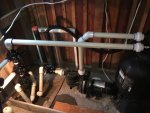Hi, last summer I started a thread about renovating my pool. I've had constant problems with being unable to keep the pump primed when running only from the skimmer and air in the pump when vacuuming. After discussion with @Arizonarob @Soupy and @mas985 the first priority was determined to be to completely replace the awful equipment pad so that can be ruled out as a problem.
I've now completed that work and the symptoms remain the same. In fact things are now worse, as the suction port has now been plumbed back to a return and now I can no longer prime the pump at all (the same as before when the suction port was closed). I've attached a picture of the new pad, sorry about the quality.
Symptoms:
1. Pump does not fully prime, it gets close then drops and slowly works it's way back before dropping off again
2. Huge bubbles come from the returns (either/both)
3. After turning off the pump it immediately drains down to the inlet and there are lots of glugs from the filter valve as I assume air works it's way back in
Video of the pump after rebuild
What I've done:
1. Checked for air leaks with smoke – nothing obvious
2. Re-lubed all the o-rings in the new unions, the pump lid, the pump body and the filter valve
So now I'm at a loss, what do I do now?
I've now completed that work and the symptoms remain the same. In fact things are now worse, as the suction port has now been plumbed back to a return and now I can no longer prime the pump at all (the same as before when the suction port was closed). I've attached a picture of the new pad, sorry about the quality.
Symptoms:
1. Pump does not fully prime, it gets close then drops and slowly works it's way back before dropping off again
2. Huge bubbles come from the returns (either/both)
3. After turning off the pump it immediately drains down to the inlet and there are lots of glugs from the filter valve as I assume air works it's way back in
Video of the pump after rebuild
What I've done:
1. Checked for air leaks with smoke – nothing obvious
2. Re-lubed all the o-rings in the new unions, the pump lid, the pump body and the filter valve
So now I'm at a loss, what do I do now?
Attachments
Last edited:





